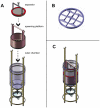A new system for the rapid collection of large numbers of developmentally staged zebrafish embryos
- PMID: 21738776
- PMCID: PMC3126846
- DOI: 10.1371/journal.pone.0021715
A new system for the rapid collection of large numbers of developmentally staged zebrafish embryos
Abstract
The zebrafish is an excellent genetic and developmental model system used to study biology and disease. While the zebrafish model is associated with high fecundity, its reproductive potential has not been completely realized by scientists. One major issue is that embryo collection is inefficient. Here, we have developed an innovative breeding vessel designed to stimulate the natural reproductive behavior of the fish. This novel apparatus allows us to collect large numbers of developmentally synchronized embryos in brief and defined windows of time, and with minimal investments in labor and space. To demonstrate the efficacy of this approach, we placed three separate groups (n = 180) of fish in the vessel and allowed them to spawn for 10-minute intervals. During these trials, which were repeated three times, the fish produced 8600±917, 8400±794, and 6800±1997 embryos, respectively. This level of embryo production is nearly twice what we were able to achieve when using conventional crossing equipment with some of the same fish, and it required significantly less room and time to set up and break down. This system overcomes major space and labor restrictions inherent in spawning equipment currently used in the field, and will greatly accelerate efforts to improve the scale and throughput of experiments.
Conflict of interest statement
Figures




References
-
- Spence R, Gerlach G, Lawrence C, Smith C. The behaviour and ecology of the zebrafish, Danio rerio. Biological Reviews. 2008;83:13–34. - PubMed
-
- Mullins M, Hammerschmidt M, Haffter P, Nüsslein-Volhard C. Large-scale mutagenesis in the zebrafish: in search of genes controlling development in a vertebrate. Curr Biol. 1994;4:189–202. - PubMed
-
- Lawrence C. The husbandry of zebrafish (Danio rerio): A review. Aquaculture. 2007;269:1–20.
-
- Engeszer R, Patterson L, Rao A, Parichy D. Zebrafish in the wild: a review of natural history and new notes from the field. Zebrafish. 2007;4:21–40. - PubMed
-
- Spence R, Ashton R, Smith C. Adaptive oviposition choice in the zebrafish, Danio rerio. Behavior. 2007;144:953–966.
Publication types
MeSH terms
Grants and funding
LinkOut - more resources
Full Text Sources
Molecular Biology Databases

